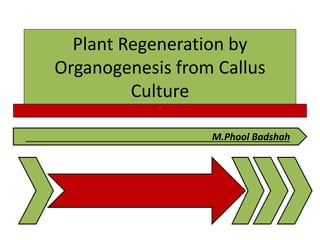
Plant Regeneration by Organogenesis from Callus Culture.pptx
- 1. Plant Regeneration by Organogenesis from Callus Culture a M.Phool Badshah
- 2. Introduction • Callus formation from explant tissue involves the development of progressively more random planes of cell division, less frequent specialization of cells, and loss of organized structures .tobacco plant is used. • There are five phases of callus growth : • A lag phase, where cells prepare to divide. • An exponential phase, where the rate of cell division is highest • A linear phase, where cell division slows but the rate of cell expansion increases. • A deceleration phase, where the rates of cell division and elongation decrease. • A stationary phase, where the number and size of cells remain constant.
- 3. Objectives and Goals • • To initiate callus cultures from explant tissue of tobacco, and to observe the growth pattern of a callus culture. • • To initiate cell suspension cultures of tobacco, and to recover callus from a cell suspension culture. • • To observe the induction of de novo shoot and root organogenesis from tobacco callus, to compare this system to adventitious organogenesis from tobacco explant tissue, and to regenerate tobacco plants from callus. • Plant Materials : • callus cultures of tobacco can be purchased from Carolina Biological Supply Company.
- 4. Equipment : • Sterile petri dishes, 100 X 20 mm • Electronic balance with enclosed weigh area, such as Mettler AE200 • Sterile Erlenmeyer flasks, 125 ml, capped with aluminum foil • Gyratory shaker, such as Lab-Line 3590 • Sterile stainless steel mesh, 75-250 iJ-m (optional), such as Cellector Tissue Sieve, VWR #62399-918, with Fine Mesh Kit, VWR #62399-951 • Sterile large-bore pipettes, 5 ml, 10 ml • Aluminum foil • Oven, such as VWR 1350FD • Inverted microscope, such as Zeiss Axiovert 100
- 5. Procedures : • Preparation of Media : • Agar Media: Agar-solidified culture media should be prepared in 100 X 20-mm petri dishes. Other culture vessels can be substituted. Magenta boxes are used for MS medium to provide more room for shoot or plantlet development in the protocols for Callus Initiation and Maintenance, Step 3, and Induction of Shoot Organogenesis, Step 4. Use petri dishes for MS medium in the protocol for Induction of Shoot Organogenesis. • Liquid Culture Media : Liquid media used for cell suspensions should be prepared in 125-ml Erlenmeyer flasks. Only 15 ml of medium per flask is used for suspension initiation, while 25 ml of medium per flask is used for subcultures of established suspensions.
- 6. a • Treatment of Materials : • Tobacco cultures do well in an incubator set at 25°C with continuous light or 16-h light/8-h dark photoperiod, 15/- tmolm-2 s- 1• A gyratory shaker should be located in a room with similar environmental conditions, but the light intensity can be lower. • Design of Experiment : • The experiments are designed to provide experience in the initiation and maintenance of callus culture, and the induction of shoots or roots from callus compared to intact leaf explant tissue. The experiment will compare two explant types for the initiation of callus cultures, and eight culture media for morphogenetic response. A minimum of four replications is sufficient, requiring a total of 32 seedlings to initiate the callus cultures and 8 -16 shoot cultures to initiate the adventitious regeneration comparison.
- 7. Protocols : • Callus Initiation and Maintenance : • Collect the aseptically germinated seedlings when the cotyledons are fully expanded and the epicotyl is beginning to emerge. Usually this will occur when the seedlings are between 7-14 days old. Place each seedling on a sterile petri dish, one at a time, to prepare explants as described below in steps 2-4. • Excise the two cotyledons from half of the seedlings. Culture them abaxial side up, or upside down, on MS-Tl medium for callus initiation. • Excise the shoot apex from the seedlings, half without cotyledons (from step 2) and half with cotyledons, and insert the stem base into MS medium. Use two shoots per vessel, one with and one without cotyledons. This will establish stock shoot cultures for future use. Subculture onto fresh MS medium on a monthly basis. • Excise the hypocotyl section from the decapitated seedlings. Culture them on MS-Tl medium for callus initiation.
- 8. a • Callus Growth Curves : • Use established callus stocks to follow the growth pattern for an extended passage cycle. A total of 24 callus pieces of similar size are needed. • Measure the initial fresh weight (zero time) of three replicate callus pieces in the laminar flow hood. Place each callus piece inside a pre-weighed, sterile petri dish to weigh the callus. Determine the fresh weight of the callus after subtracting the weight of the petri dish. • Schedule of Observations and Measurements : • Callus Cultures :Observe the explants weekly for callus formation. At the end of the first monthly passage, summarize the callus response according to origin of callus in the different explants, callus morphology, and color. Observe and record fresh weight and dry weight growth of established callus on designated days or weeks according to the protocol given. Plot the growth curves over the extended passage.
- 9. Results : • Callus formation from tobacco explants approached 100% frequency. • A sigmoidal pattern of callus growth was observed. • The cotyledon explants usually responded faster than hypocotyl explants. • Shoot regeneration frequencies from tobacco cultures approached 100% on optimal media such as MS-T2 and MS-TS. • The individual media supported either shoot organogenesis, root organogenesis, callus growth. • Organogenesis from callus took longer to initiate and to produce normal shoots compared to adventitious shoot formation occurring directly from leaf explants. • Root regeneration frequencies from tobacco cultures approached 100% on optimal media such as MS-T3.